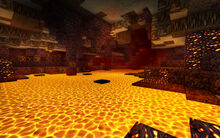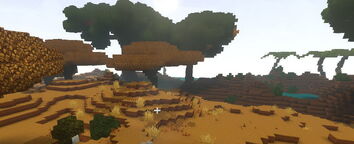
Basic Information[]
All Creativerse game worlds consist of different layers, ranging from the overworld above to the Corruption deep below.
Each layer is made of specific blocks, contains different Nodes of Ore and is inhabited by endemic creatures. All underground creatures are usually aggressive, except if you set them to "peaceful"/defensive for your game world/s in the world options.
Altitudes[]
This table lists which underground layer the game will automatically display at which altitude:
| Altitude | Layer | Nodes with Ore | Power Cell required |
|---|---|---|---|
| 81-255 | Surface | Coal, Obsidian | None, sometimes Stone Mining Cell |
| 62-80 | Fossil layer | Coal, Obsidian | Often Stone Mining Cell |
| 40-61 | Stalactite layer | Iron | Often Obsidian Mining Cell |
| 25-39 | Lava layer | Diamond | Often Iron Mining Cell |
| 0-24 | Corruption layer | Lumite | Often Diamond Mining Cell |
| Altitude is the second/middle number when typing // in the chat | |||
However it's safe to state that in reality there are no exact altitudes for each layer, since the actual composition of Creativerse game worlds is different from what the environment indicator in the top right corner automatically displays.
For example: when you are swimming in an Ocean at the height of 80 blocks (counted from the very bottom) with several blocks of Water and Sand below you, the environment display will indicate that you are in the Fossil layer, which is obviously not true at all.
On the other hand you will be able to find typical natural blocks of the Fossil layer, like Bedrock and Limestone, starting to form the fringes of Caves at an altitude of 92 or higher in the Mountains and other Biomes.
Sometimes you will not find any rocks from the Stalactite layer when digging your way down until reaching an altitude of 54, while sometimes at Shores or in Canyons, structures made from Stalactite can be found at the entrances of Caves reaching up to an altitude of 80 or even higher.
Also please note that older worlds are a bit different. Many of them feature Diamond Nodes on the Stalactite layer and Corruption layer too, as well as Iron Nodes on the Fossil layer and Lava layer. Very old worlds are even way more "randomized" - they do not feature any special Biomes like Jungles, Swamplands or Savannahs, while all blocks from the Stalactite layer are very common visible on the surface at the flanks of Mountains, including Glowing Mushrooms.
Mining Cells[]
To advance to deeper levels underground, digging is advised, and each underground layer will require stronger Gauntlet Cores to be equipped. Only very rarely natural Caves and tunnels might lead from the underground to the Lava layer, however nearly no Caves from the surface lead all the way down to the Corruption layer.
To mine Stone, a Wood Gauntlet Core is required. You will also need to craft a Stone Gauntlet Core and equip it to mine harder rocks like Bedrock and Limestone from the Fossil layer, but also for Dark Canyonstone, Ruddy Canyonstone and even caramel-brown Canyonstone (unlocks a lot of recipes) high up in Canyons, as well as for Peakstone found at Mountain tops.
To mine through Stalactite and Siltstone of the underground layer below the Fossil layer, you will need at least an Obsidian Gauntlet Core or better, and even stronger Gauntlet Cores for even deeper underground layers.
To prevent falling to your player character's death, you might want to create stairways (using them will be made smoother by applying Stairs), or ladders (non-flammable Stone Ladders or Industrial Ladders are recommended when reaching the Lava layer).
You can also try to create "elevators" by placing Fans or by simply placing Mineral Water to run down a hole (your character will not drown in it, but instead even be healed, however there is a buoyancy to actively stem against, plus it might take a while for the Mineral Water to flow down, which can make descending unsafe as long as you don't place enough units of liquid along the way down).
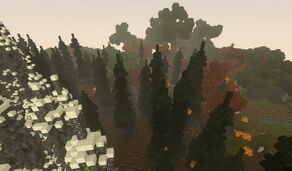
The surface[]
is divided into a large variety of Biomes like Woodlands (the most common entry points for player characters), Oceans (the largest surface "Biomes"), Forests, Grasslands, Jungles, Savannahs, Sandy Dunes, Canyons, snow covered Mountains, Frozen Deserts/Icy Plains, Hills and so on - of different kinds.
Every biome is home to specific Creatures, and at night additional Creatures will appear in most biomes; a few more Creatures may also come from Caves now and then.
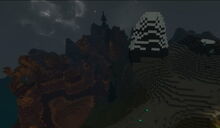
Surface biomes can consist of many different blocks depending on the respective biome; but most of them are based on a foundation made of Dirt, Stone and Water, often only covered with a thin surface layer made of either green Grass, Savannah Grass, Dead Grass, Detritus or Matted Needles.
While Rocky Dirt replaces common Dirt (and parts of the usual layer of grey Stone too) in Savannahs, Sandstone does the same in Canyons.
Ocean floors usually consist of Sand instead of common Dirt, and under the Waters of Oceans, Limestone very often forms a thick layer above the topmost Fossil layer consisting of grey Stone, which you will have to cross in order to reach Bedrock, Fossils and Magnetite even deeper underground.
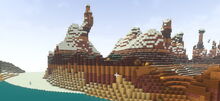
Beware of the night on the surface (except for on worlds set to "peaceful"), as aggressive Night Creatures (like Arctic Mirus on Peakstone or Snow) might show up all of a sudden and/or can safely come out of caves. You should also take care not to walk on Snow or Ice for too long as this can cause freezing damage over time.
All over this surface not only creatures but also Wood Treasure Chests can spawn in range of view. These chests will only appear in unlit areas at night and (like all creatures) can only spawn on solid blocks, not on liquids nor in the air; they might even show up on treetops occasionally. They will often have a number of Coal, Flowers and other useful resources inside, additionally to that rare findings like Perfumes, accessories for pets or rare Recipes.
Nodes of Coal and Obsidian can be found embedded in grey Stone in the Mountains or at rocky recesses close to rivers. You will need to equip a Stone Mining Cell or better to collect/mine caramel colored Canyonstone, Dark Canyonstone, Ruddy Canyonstone, Peakstone or Ice. To scoop up Water, no Power Cell is required.
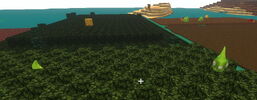
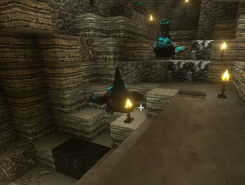
The Fossil layer[]
is made of Stone, Limestone, Bedrock and patches of Magnetite as well as blocks of Fossils. Also Nodes of Coal and Obsidian can be found in this layer. You will need a Stone Mining Cell (or better) to mine Magnetite, Bedrock and Limestone, while Fossils do not require any Power Cell to be collected.
Many natural shallow Caves usually lead down into the Fossil layer, and sometimes waterfalls from the surface will reach down into the Fossil layer too.
Night creatures are hiding here in the dark; mostly Night Rocksters, but also Night Pigsies, as well as Mirus. Sometimes surface-creatures or Night Chizzards might wander or fall down into the Fossil layer too. Stone Treasure Chests can be found occasionally here in dark places (placing light will prevent creatures from spawning, but also will prevent the spawn of treasure chests...).
To mine Limestone, Bedrock and Magnetite you will need at least a Stone Mining Cell (or better).
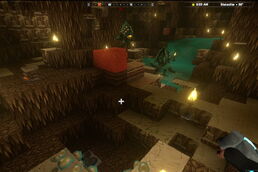
The Stalactite layer[]
is made of Stalactite, Siltstone, patches of Saltrock, Mud, Mold and sometimes Glowing Mushrooms. Nodes of Iron can be found in this layer, also Coal and further down also Diamond and patches of Tourmaline. You might discover small pools and perhaps even small cataracts of Tar, but also many pools and waterfalls made of healing Mineral Water on the Stalactite layer too.
This layer is mostly dark except for the faint illumination of glowing mushrooms and the green-yellow light of creatures when they touch Mineral Water. You will find Mirus and Warmworms on the Stalactite layer, sometimes also Night Rocksters and rarely Night Pigsies from further up. Obsidian Treasure Chests can be discovered occasionally on this layer.
To mine Stalactite, Siltstone, Salt Rock, Mold, Glowing Mushrooms and Tourmaline you need at least an Obsidian Mining Cell. To scoop Tar, at least an Iron Mining Cell is necessary, and to scoop Mineral Water, you'll need at least a Diamond Mining Cell (or better). You can change Tar into Coal by using Freeze Bombs on it.
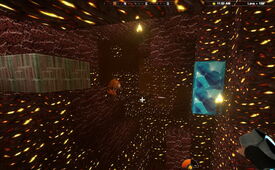
The Lava layer[]
is made of Hardened Lava, Igneous Rock, Sulfur, patches of Tourmaline and flowing liquid Lava - mostly in the form of lakes. This layer is fairly lit by the glow of Hardened Lava and sometimes pools of liquid lava (not oceans though).
Nodes of Iron and Diamond can be seen here too, and further down (closer to the corruption layer) a few nodes of Lumite, which currently is the best "metallic" material in Creativerse.
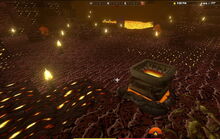
On the Lava layer you will encounter Hotfeet and Warmworms spawning on Hardened Lava, Igneous Rock and other blocks in areas not lit by artificial lighting - sometimes also Mirus might descend from other layers. Iron Treasure Chests are rare and valuable findings on the lava layer. To mine Hardened Lava, Igneous Rocks and Sulfur, at least an Iron Mining Cell is needed, and to scoop liquid Lava you'll need a Diamond Mining Cell (since update R62 on April 19th 2019) or better.
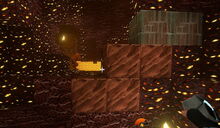
The Lava layer features an environmental challenge - heat. At the bottom of your screen above your health-bar you'll see a scale labelled with a flame-symbol which will slowly be filled with red color while you stay on this layer or near any hot blocks like Hardened Lava or liquid Lava.
As soon as the scale has fully turned red, your character will start to burn and loose health every second. Touching liquid Lava or being attacked by special attacks from Hot Feet will burn your character immediately - even if the heat-scale has not filled up yet. If you back away quickly and use healing measures, then your character will not die immediately. You can liquify Hardened Lava by throwing Fire Bombs at these blocks. In return, cooling down liquid Lava with Water, Mineral Water or especially Freeze Bombs will turn them into Hardened Lava, while Hardened Lava can be cooled down by the same procedures to turn into Igneous Rock.
What to do against heat-damage:[]
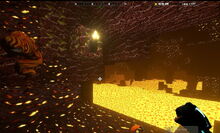
You can either run back up to the Stalactite layer and wait for the scale to clear until descending again, or you can use Fire Resistance Potions (which will even enable you to swim in liquid Lava) that offer their effects for full 10 minutes. These potions will not protect your character against fire damage though (like from Hot Feet or liquid Lava). Instead blazing Food is able to reduce the fire damage over time afflicted by Hot Feet or liquid Lava, some can even reverse it, so catching fire will heal your character instead of reducing its health.
It is hard to survive on the Lava layer by merely constantly healing your character whenever needed (for example by using Healing Potions), however it might do long enough until you have dug your way up to the Stalactite layer to cool down there. You can also build sheltered rooms within the Lava layer with enough layers of any material that is not hot (but this has gotten harder to do since R24). Ice and Snow will melt into Water, except if you use a large amount of these put together. Ice Slopes are sturdy and will not melt, but they also do not cool down the environment temperature as of R26 in December 2015.
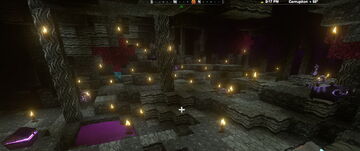
The Corruption layer[]
The Corruption layer is made up of Corrupted Stone, Corrupted Dirt, Corrupted Wood forming long branches or roots with Corrupted Leaves as small treetops hanging upside down or growing up from the ground, sometimes even from large lakes of Corrupted Water. There is a top layer of solid corrupted blocks and a bottom layer of corrupted stone, dirt and water based on one small unmovable layer of End of the World-blocks.
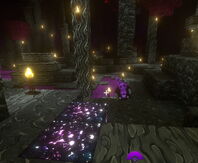
When touching Corrupted Water or sometimes other corrupted blocks, other blocks can be corrupted too; like Corrupted Grass, Corrupted Elderwood, and Corrupted Ashenwood Leaves. At least Diamond Mining Cells are necessary to mine / pull corrupted blocks of any kind. For Corrupted Water, you'll need to equip a Diamond Mining Cell or better.
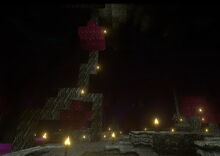
Between those two layers there is often a lot of free space (air) with only some strands of corrupted wood and stalactite-like as well as stalagmite-like extensions of corrupted stone in between. Nodes of Diamond and Lumite can be found embedded into the top layer and the bottom layer, sometimes covered with corrupted water or sparkling from the "ceiling" above. Diamond Treasure Chests might spawn in the darkness on solid surfaces here or there too.
The Corruption layer is inhabited by Corrupted Pigsies, Corrupted Mirus, Corrupted Chizzards, Corrupted Leafies (spawning on corrupted leaves) and Things. Most other creatures will perish when being corrupted. Beware of the Thing, as it only spawns around players, and the more players there are, the more likely for it to spawn. It is currently the most powerful creature in the game.
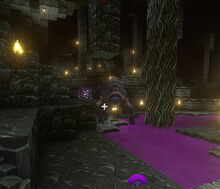
The Corruption layer features another environmental challenge - corruption. At the bottom of your screen above your health-bar you'll see a scale labelled with a biohazard-symbol which will be filled with violet color while you stay on this layer. Corruption poisons your character faster than their body-heat will rise. If the scale is full, your character will be corrupted (poisoned) and start to loose health every second quickly. Touching corrupted water will corrupt your character immediately even before the scale is filled up.
What to do against corruption-damage:[]
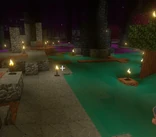
A decent weapon against corruption is the Healing Beacon. You can place Healing Beacons into corruption and after a short while they will purify their direct surroundings. When being close to Healing Beacons, your character will not only be healed over time, but the scale for being corrupted will go down as well. Throwing Purification Bombs will usually heal many layers of corruption, including water, so that the corruption of your character will even go down while staying at those spots.
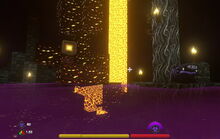
Since R22 there's another neat option to use on the Corruption layer: "corrupted" meals made in the Cooking Station like Corrupted Pie or Corrupted Sandwich will make corruption (the normally poisonous effect) heal your character over time for a few minutes, and also grant more maximum-health, which will enlarge your health-bar. Other corrupted food like Corrupted Bread and Corrupted Soup will at least reduce the damage your character takes from getting corrupted (even though the tool-tips have not been changed accordingly yet).
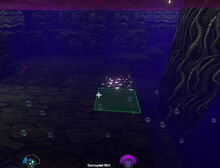
You can also use Corruption Resistance Potions (which will even enable you to swim in corrupted water) and/or try surviving by healing your character constantly (for example with Healing Potions), and you can build pedestals and/or platforms reaching into the air far enough from any corrupted blocks (perhaps with a pool of Healing Mineral Water on top) or even sheltered rooms using enough layers of uncorrupted blocks.
here are a few additional pictures showing older versions of underground layers with slightly different textures than nowadays:
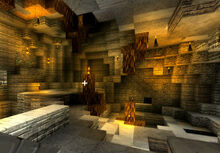
Stalactite Layer
Players can create artificial biomes too[]
- even in the sky, underground or underwater. Depending on the natural blocks that the biomes are built from, the biome-endemic types of Creatures and also Treasure Chests will then randomly spawn. Artificial biomes will usually not be displayed as such in the top right corner of your screen.
To build an artificial biome, a small to large number of biome-specific natural surface blocks has to be placed into one chunk (16x16x16 area) of the world. A small flat platform of 10x10 blocks (only 1 block "thick"/deep) is usually sufficient to make Creatures and Treasure Chests spawn. In some cases, even only one natural block will already be enough to sometimes let a certain Creature type or (very rarely) Treasure Chest spawn.
Please note that artificial biomes can interfere with each other, so if you place different biomes close to each other, one or more biomes might not spawn any Creatures. Repeatedly visiting artificial biomes will often not let any more Creatures spawn. Leaving an area can cause already spawned Creatures to vanish after a while, and they might not show up again if you revisit the area too soon after that. Artificial biomes might not spawn any Creatures if a Touchstone is nearby either. Artificial biomes on the Fossil layer altitude might sometimes not work at all. Fossil layer blocks on the other hand might not spawn Fossil layer Creatures well on other altitudes. Also, changing from one biome to another can sometimes make Creatures spawn that actually belong to the biome that you have just left. This often happens with Rocksters and Autumn Leafies.
- Peakstone can let Rambeaus spawn during the day, and Arctic Mirus during the night
- also blocks of Snow next to blocks of common grey Stone might sometimes make Rambeaus spawn
- Snow and Ice mainly lets Blizzard Chizzards spawn during the day, and Arctic Mirus at night
- Sandstone can let Dustevils and Trogs spawn during the day, but Night Pigsies and sometimes Night Rocksters at night
- Canyonstone, Dark Canyonstone, Canyon Floor and Ruddy Canyonstone will let Trogs more often spawn than Dustevils, especially when Mineral Water is also placed there or nearby
- Detritus can make Feral Pigsies and green Leafies spawn during the day, Night Pigsies and Night Leafies, sometimes also Night Chizzards at night times
- Sand, especially if close to Water, Mineral Water or Bog Water, will let Rocksters and Pebbles spawn during the day (even more so when Seashells are close by) and Night Rocksters in the night
- Bog Water on or near green Grass will make Feral Pigsies and Mossy Leafies spawn during the day, but Night Pigsies and Night Leafies in the night
- Weepwood Leaves and Weepwood Logs can let Mossy Leafies spawn during the day
- Wildwood Leaves, Wildwood Flowers and Shorewood can make Chizzards spawn during the day, and Night Chizzards, but also Night Leafies during the night
- Autumnwood Leaves of all kind can make Autumn Leafies spawn during the day, and Night Leafies during the night
- Cactus blocks and Cactus Flowers can make Dried Leafies spawn (even more so if Rocky Dirt and/or Sand is nearby), but also Dustevils during the day, and Night Leafies as well as Night Pigsies in the night
- Savannah Grass and Rocky Dirt can make BossHogs and Shrewdshrews spawn during the day, but Night Pigsies during the night
- most tree leaves can make Leafies and sometimes common yellow Pigsies spawn during the day, as well as Night Leafies and Night Pigsies during the night
- Night Hoglets and Night Twiggies usually only spawn in or next to Woodlands and Forests at night
- Dirt, green Grass and Dead Grass will occasionally let Pigsies spawn, but can also attract green Leafies, especially if Crops are near
- Corrupted Blocks will make Corrupted Creatures spawn during day and night, but only in darkness. Keepas of all kinds, even the rare Golden Keepas, also spawn most often on Corrupted Blocks
- blocks from the Lava layer will make Hot Feet and Warmworms spawn in darkness - Hot Feet will burn away in the sunlight
If you want Creatures and/or Treasure Chests to spawn, do not place any artificial lighting!
You might place Wildwood Flowers for a somewhat dim illumination (they can occasionally cause Chizzards, Leafies, Night Leafies and/or Night Chizzards to spawn though) or any blocks/objects that glow by themselves but will not illuminate their surrounding, like LEDs or colored glass blocks - like Diamond Glass for example.
A while after the artificial biome has been built from natural surface blocks (not from any crafted blocks!), the specific types of Creatures typical for this biome will spawn there. Sometimes Creatures will start to spawn while you are still creating the biome, but sometimes they will stop spawning for a while afterwards. Some Creatures need complete darkness though in order to spawn (walls and ceilings will help with that), and a few types of Ceatures will only spawn during night-times, even if complete darkness is provided.
Treasure Chests will occasionally also show up in artificial biomes on natural solid blocks. Blocks taken from underground layers will make Treasure Chests of higher quality spawn though. Chests spawn best at nightfall, so using a Bed is recommended to skip the day.
On layers of certain tree leaves their according Flowers will - slowly - grow in time (only applies to Blue Flowers, Red Flowers, Yellow Flowers and Wildwood Flowers). Queen Bees might spawn occasionally on nearly all type of tree leaves (except for Corrupted Leaves) all by themselves and then will turn into up to 6 blocks of Beeswax automatically if the area temperature and neighbouring biomes allow for this to happen.

